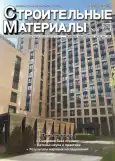On increasing the crack resistance of reinforced concrete structures by introducing fiberglass nets into the protective layer of concrete
- Authors: Kurshpel A.V.1, Lyskova T.E.1
-
Affiliations:
- Ural Federal University named after the first President of Russia, B.N. Yeltsin
- Issue: No 8 (2024)
- Pages: 17-24
- Section: Статьи
- URL: https://ter-arkhiv.ru/0585-430X/article/view/635772
- DOI: https://doi.org/10.31659/0585-430X-2024-827-8-17-24
- ID: 635772
Cite item
Abstract
Under operating conditions, the protective layer of concrete undergoes significant internal and external influences that lead to the formation of cracks. To increase the reliability and durability of reinforced concrete structures, it is proposed to install fiberglass nets in the protective layer of concrete, which is most susceptible to various aggressive influences during the operation of structures. The purpose of this work was to study the effect of fiberglass nets on increasing the crack resistance of the protective layer of concrete. The forces in the stretched concrete and in the rods of the fiberglass mesh located in the protective layer of concrete are calculated theoretically and using the software package «LIRA-CAD 2016» for a strip of concrete reinforced with a fiberglass mesh. The relative movements of the nodes in concrete and in the grid are determined and the obtained values are compared. As a result of the study, it was found that with a short-term effect of the load, fiberglass nets in the protective layer of concrete do not significantly affect the formation of cracks, with a long-term effect of the load, the presence of fiberglass nets reduces the formation of cracks by up to 2%. After the formation of microcracks in concrete, including from shrinkage deformations, fiberglass nets significantly hinder their further development.
Full Text
About the authors
A. V. Kurshpel
Ural Federal University named after the first President of Russia, B.N. Yeltsin
Author for correspondence.
Email: a.kurshpel@yandex.ru
Candidate of Sciences (Engineering), Institute of Civil Engineering and Architecture
Russian Federation, 17, Mira Street, 620002, EkaterinburgT. E. Lyskova
Ural Federal University named after the first President of Russia, B.N. Yeltsin
Email: tatianalysk@yandex.ru
Master, Institute of Civil Engineering and Architecture
Russian Federation, 17, Mira Street, 620002, EkaterinburgReferences
- Karpenko N.I., Karpenko S.N. On the determination of concrete strength under triaxial compression. Zhilishchnoe Stroitel’stvo [Housing Construction]. 2013. No. 7, pp. 27–28. (In Russian).
- Chernousov N.N., Bondarev B.A., Sturova V.A., Bondarev A.B., Liventseva A.A. Аnalytical dependences of the effect of material density on the strength and deformability of structural concrete under axial compression. Stroitel’nye Materialy [Construction Materials]. 2022. No. 5, pp. 58–67. (In Russian). https://doi.org/10.31659/0585-430X-2022-802-5-58-67
- Tang V.L., Bulgakov B.I., Aleksandrova O.V. Mathematical modeling of the influence of raw materials on the strength of high-quality fine-grained concrete under compression. Vestnik of MGSU. 2017. Vol. 12. No. 9 (108), pp. 999–1009. (In Russian). https://doi.org/10.22227/1997-0935.2017.9.999-1009
- Kurnavina S.O., Tsatsulin I.V. Influence of unclosed cracks in the compressed zone of concrete on the bearing capacity of bending reinforced concrete elements. Stroitel’stvo i rekonstruktsiya. 2021. No. 2 (94), pp. 28–38. (In Russian).
- Gaohang Lv, Kai Wang, Xuesen Zhang, Chuanyi Ma, Quanyi Xie, Jian Liu. A characteristic model for the relationship between cracking and bearing performance of reinforced concrete. Construction and Building Materials. 2024. Vol. 428. 136335. https://doi.org/10.1016/j.conbuildmat.2024.136335
- Xiao Zhang, Kaixiang Liu, Jiacheng Zhang, Jiahang Hao, Shujie Han, Xiaolong Wang, Yijun Peng. Characteristics of crack spacing and crack width movement of early-age partially continuous reinforced concrete pavement under environmental loading: A full-scale field investigation. Construction and Building Materials. 2024. Vol. 422. 135832. https://doi.org/10.1016/j.conbuildmat.2024.135832
- Karpenko N.I., Kolchunov Vl.I., Kolchunov V.I., Travush V.I., Dem’yanov A.I. Deformation of reinforced concrete structures during bending with torsion. Stroitel’nye Materialy [Construction Materials]. 2021. No. 6, pp. 48–56. (In Russian). https://doi.org/10.31659/0585-430X-2021-792-6-48-56
- Yating Zhang, Jeffery Roesler, Sachindra Dahal. Predicting transverse crack properties in continuously reinforced concrete pavement. Construction and Building Materials. 2023. Vol. 364. 129842. https://doi.org/10.1016/j.conbuildmat.2022.129842
- Kurshpel A.V., Kurshpel V.Kh. About the mechanism of destruction of the protective layer of concrete due to reinforcement corrosion. Stroitel’nye Materialy [Construction Materials]. 2021. No. 12, pp. 55–60. (In Russian). https://doi.org/10.31659/0585-430X-2021-798-12-55-60
- Fedosov S.V., Rumyantseva V.E., Krasilnikov I.V. Metody matematicheskoy fiziki v prilozheniyakh k problemam korrozii betona v zhidkikh agressivnykh sredakh [Methods of mathematical physics in applications to the problems of concrete corrosion in liquid aggressive environments]. Moscow: ASV. 2021. 244 p.
- Tongyan Pan. Continuous damage of concrete structures due to reinforcement corrosion: A micromechanical and multi-physics based analysis. Journal of Building Engineering. 2024. Vol. 95. 110139. https://doi.org/10.1016/j.jobe.2024.110139
- Kotov D.S. Shrinkage deformations of concrete modified with chemical and finely dispersed mineral fillers. Magazine of Civil Engineering. 2009. No. 7 (9), pp. 11–21. (In Russian).
- Karpenko N.I., Kaprielov S.S., Bezgodov I.M., Moiseenko G.A., Stepanov M.V. Study of shrinkage deformations of fine-grained high-strength concrete and steel fiber concrete with rational fiber content Izvestiya of higher educational institutions. Technology of textile industry. 2018. No. 3 (375), pp. 227–230. (In Russian).
- Petr Havlásek, Vít Šmilauer, Lenka Dohnalová, Radoslav Sovják. Shrinkage-induced deformations and creep of structural concrete: 1-year measurements and numerical prediction. Cement and Concrete Research. 2021. Vol. 144. 106402. https://doi.org/10.1016/j.cemconres.2021.106402
- Bondarenko V.M. et al. Zhelezobetonnyye i kamennyye konstruktsii [Reinforced concrete and stone structures. 2nd ed., revised and enlarged]. Moscow: Vishaya Shkola. 2002. 876 p.
- Alekseev S.N. Korroziya i zashchita armatury v betone [Corrosion and protection of reinforcement in concrete]. Moscow: Gosstroyizdat. 1968. 233 p.
- Russian Federation Patent No. 2744905 Sposob povysheniya nadezhnosti i dolgovechnosti zhelezobetonnykh konstruktsiy [Method for increasing the reliability and durability of reinforced concrete structures] / Kurshpel V.Kh., Kurshpel A.V. Declared 26.12.2018. Published 26.06.2020. Bulletin No. 18.
Supplementary files










